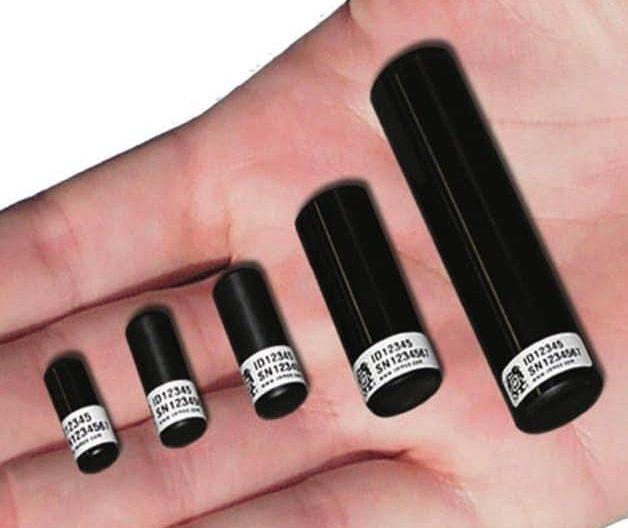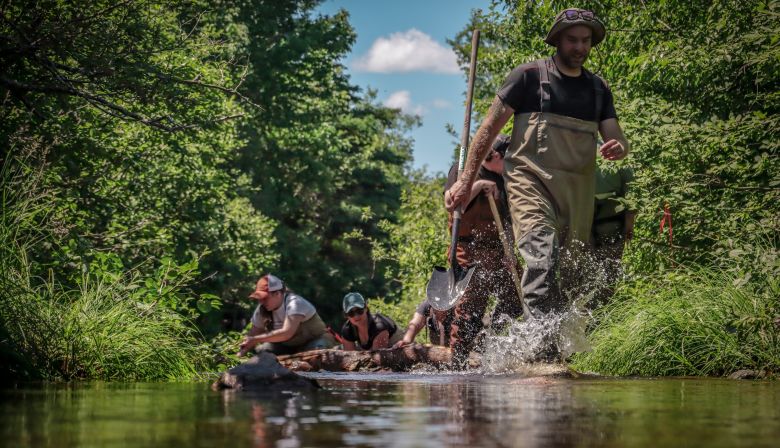
Subscribe & stay up-to-date with ASF

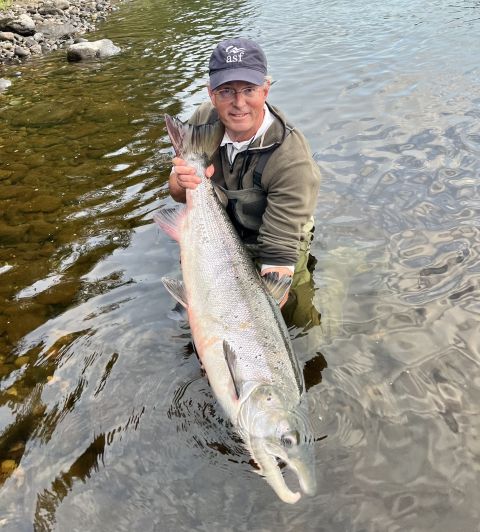
Field work is also off to a strong start across the board. ASF’s Kris Hunter and I spent yesterday with NSSA’s Research Scientist, Eddie Halfyard touring West River, Sheet Harbour. We visited the lime dozer, artificial reef and cold water project sites. Stay tuned for details on these exciting projects and many more to come from the NSSA.
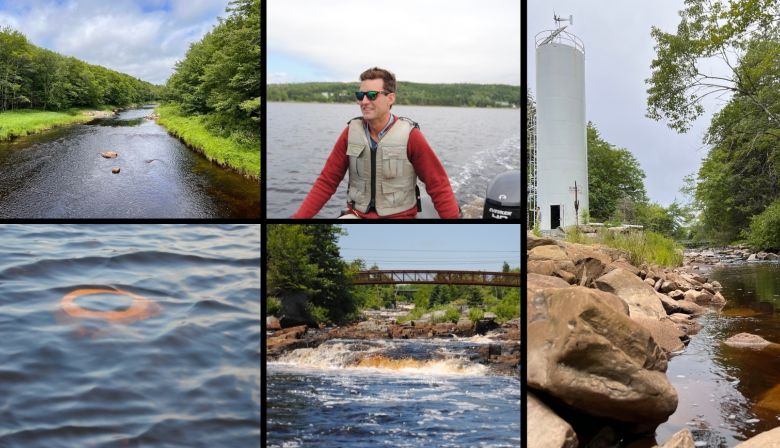
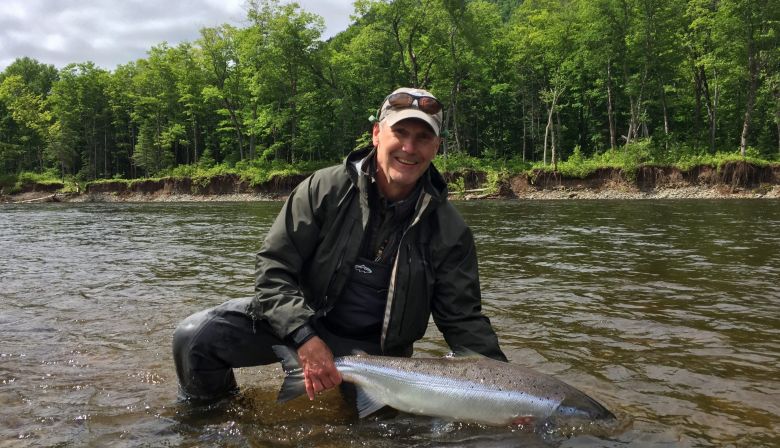
It has often been said by seasoned anglers that no two days salmon fishing are alike, and this past week in NL certainly proved that. The week started with low water levels and warm water temperatures for most rivers on the island portion of the province, and as a result fishing was fairly slow. On a positive note, anglers reported seeing good signs of fish in most rivers, but said fish were rather sluggish and would rise to the fly once but would not rise a second time. This is a common occurrence during warm water fishing. However, by mid week heavy rains resulted in water levels increasing dramatically, all within a twenty-four-hour period. Water temperatures also plummeted on many of these same rivers due to a province wide cold front that moved in. On rivers that were not blown out, reports from anglers indicate they enjoyed good fishing.
Central NL did not receive any heavy rain and as a result water levels on the Gander River, and a few other rivers adjacent to it, remain low. The good news is that water temperatures have cooled down a little on these rivers, and anglers are reporting good fishing success.
In Southern Labrador, warm water temperatures and very high-water levels resulted in a relatively poor start to the fishing season. But by early last week fishing conditions improved as high-water levels receded and water temperatures began to fall. Those who fished the region last week say it was excellent.
As we often say in NL, if you don’t like the weather here, just hang around for five minutes because it’s bound to change. With improved angling conditions on most rivers in the province this past week (with a few exceptions), many anglers reported excellent angling and a good number of fish showing.

Regional Summary:
Southwestern Newfoundland
Fishing was fairly good on most Bay St. George rivers early last week but heavy rain mid-week led to extremely high water levels, that all but prevented anglers from fishing. These water levels are just now receding and are once again starting to approach normal flows.
Western Newfoundland
On the Upper Humber River water levels were low and the water temperature was fairly warm during the early part of last week. While anglers were still hooking a few fish at that time, things were much slower than usual for this time of year. By mid-week heavy rain caused the river to rise from about 35 c/m/s to 350 c/m/s. Flood conditions put an end end to nearly all angling in the area. The water level has since started to recede but remains high at about 140 c/m/s. Meanwhile, the Lower Humber is starting to produce a few fish despite high water levels.
Brad LeDrew with Arluk Outfitters on Main River (Sops Arm), reports that by early last week the number of fish in the river was really starting to pick up. Steve Sutton (ASF) reports that fishing was a little slower than usual last week on Main River because the water temperature was on the warmer side, but fish (mainly grilse) were being hooked there. Again, heavy rain during the middle of the week caused the water level on Main River to reach flood conditions, virtually bringing all angling on the river to a stand still. However, the water level has since started to recede and is now approaching fishable levels again.
Northern Peninsula
Water levels on most Northern Peninsula rivers ranged from low to medium last week, because while they did receive some rain last week they did not get the heavy rain experienced in Southwestern NL. While water temperatures were a little on the warm side, early last week things cooled down after the rain, and water levels are now at medium levels. Kirk Beverly reports that angling on Castor River was good last week on the upper section, whereas things were slower on the lower section and the first run of fish appears to have already gone through that area. Reports also indicate there was fairly good fishing last week on the Torrent River, St. Genevieve River, and Main Brook (Salmon Brook). However, things were still slow on River of Ponds because water levels were pretty high as of last week.
Southern Labrador
Rob French (Big Land Adventure Lodge) reports that fishing was great on the Pinware River last week with a good mix of large fish and grilse. Water levels were just a tad high at the time and water temperatures were good. However, the water level is now high due to rain experienced late last week, which is currently restricting access to many pools on the river. But there is still an excellent sign of fish in the river. Good reports also came from the Forteau River last week. However, a little further North on the Hawke River, fishing was a slow due to low water levels and warm water temperatures. In contrast, Dwight Lethbridge (Pratt Falls Lodge) reports that water levels and water temperatures on the Eagle River were great last week and the fishing was nothing short of fabulous, with a good mix of large salmon and grilse being caught. For more on the Eagle River see their report: Pratt Falls Lodge – Eagle River Report.
DFO has released their salmon counts up to July 08, 2022, and returns overall are encouraging: Atlantic Salmon Fishway Counts.
The Department of Fisheries, Forestry and Agriculture, Wildlife Habitat Canada, and the Friends of Salmonier Nature Park are hosting Youth Hunting and Angling Education Workshops. For more information visit: www.gov.nl.ca


ASF continues to work with Maine Department of Environmental Protection (DEP) on Walton’s Mill Dam to monitor water quality above and below the impoundment. The hope is that after the dam is removed, dissolved oxygen and temperatures will improve enough to re-list the stream as class A (from class B), which would provide better water quality regulation.
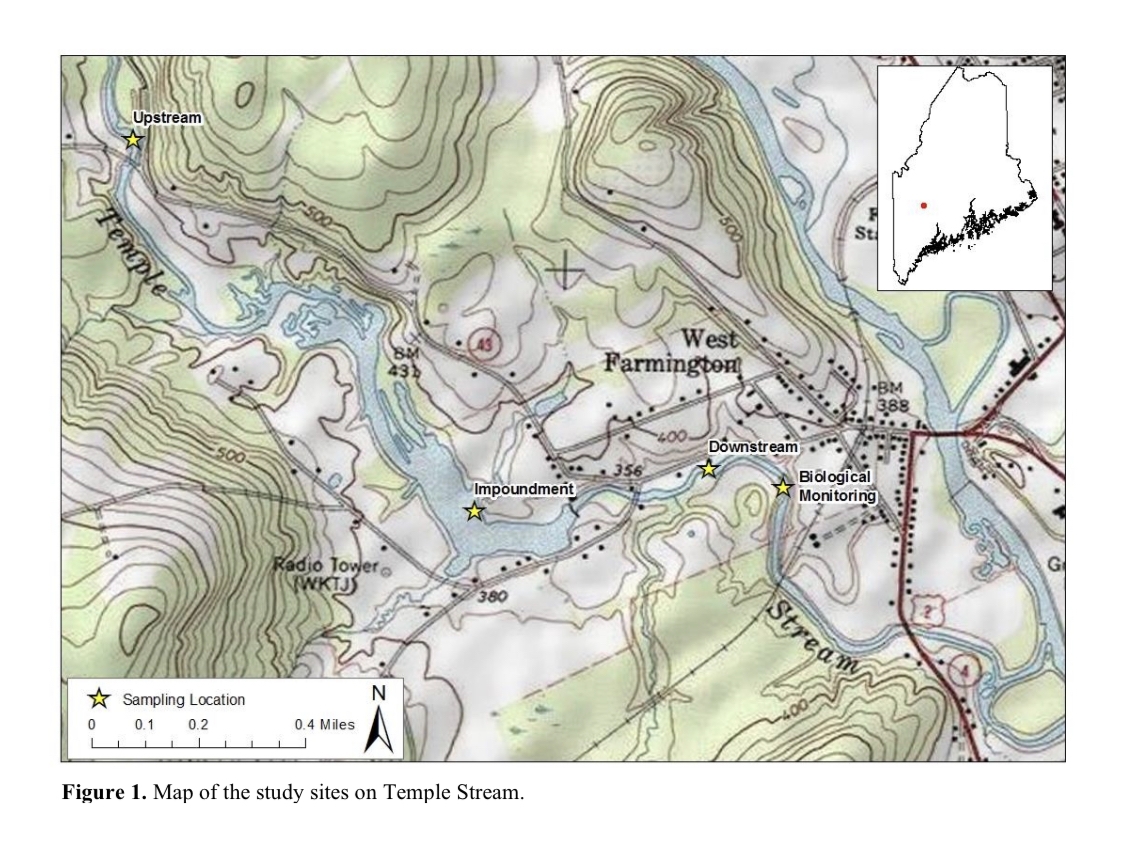

Maine Department of Marine Resources (DMR) Scientist, Jason Valliere shares the latest from the Penobscot in the attached report. He notes that the river was over 23C /73F all last week and that they are seeing just a few fish each day. DMR’s next report will be shared on July 22nd and will be included within the subsequent edition of RiverNotes.
In partnership with The Nature Conservancy in Maine (TNC), ASF is seeking a Habitat Restoration Project Manager to oversee and manage all facets of habitat restoration and fish passage projects, with a primary focus in Maine’s Penobscot River Watershed. The start date is October 1, 2022. To apply, submit a resume and cover letter to Catherine Birmingham cbirmingham@asfmaine.org. Deadline for applications is August 12, 2022.
Please see posting : Job Announcement – ASF Habitat Restoration Project Manager
DMR’s Jennifer Noll writes:
Temperatures have been somewhat steady, but warm on main stem Kennebec (~23°C) and cool on the Sandy River (~20°C). Kennebec River flow levels in Sidney, ME have been extremely steady at 2,740 cfs throughout the week (USGS current conditions).
Atlantic salmon captures have continued slowing down this past week at the Lockwood fish lift and consist of only grilse (1 sea-winter). Nine Atlantic salmon were captured since the last report, eight were new fish and one was a recapture. This recapture likely dropped down from the Sandy River as that is the closest river that would have a grilse with an adipose punch. Most of the scales have been read to date and the run is 49% wild (or naturally reared), 51% hatchery (smolt stocked). Of the naturally reared salmon, 5% are grilse and 95% are multi sea-winter salmon. Of the hatchery origin fish, 80% are grilse and 20% are multi sea-winters.
This year, returning multi sea-winter (MSW) adult salmon will be tagged with acoustic tags. The goal of this tagging study is to understand movement ecology and habitat use by natural-origin and hatchery salmon, thermal refuge use, and identification of spawning habitat. So far 17 returning MSW salmon have been tagged and released in the Sandy River. Seven acoustic receivers were set throughout the Sandy River drainage on Thursday/Friday of last week. Two more receivers are planned to be deployed in the Sandy River within the coming weeks.
Lockwood fish lift (mainstem Kennebec) total catches for 2022 (as of July 11): 81 Atlantic salmon
Benton Falls (Sebasticook River) total catches for 2022 (as of June 12): 5 Atlantic salmon
Androscoggin River
DMR’s Mark Pasterczyk writes:
Brunswick Fishway (BFW): One Atlantic salmon passed upstream on the week of July 4th through to July 10th which brings the season total to 16 passed upstream. The one salmon that passed upstream on Friday, July 8th at the BFW was of multi sea-winter (MSW) size. The water temperature was at 24.3 degrees Celsius at 4:30 pm on July 10th, 2022.
Brunswick fish lift (main stem Androscoggin) total catches for 2022 (as of July 4th): 16 Atlantic salmon
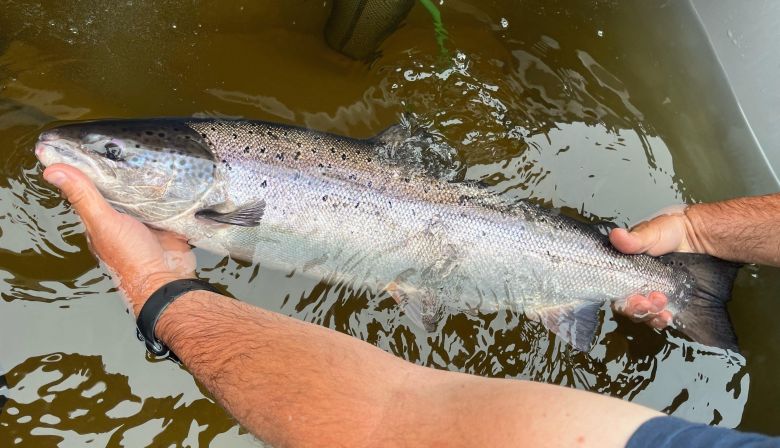
Amy Weston, NSSA’s Manager of Habitat Programs shares:
We offer this training each summer to the field staff and volunteers of community groups, river associations, and Indigenous-led organizations involved in the Nova Scotia Salmon Association’s Adopt-A-Stream program. This year we held a day in Zwicker Brook on the Lahave, Trout Brook on the Mira and MacKay Brook on the St. Mary’s River where we had 20 or so participants.
The sessions provide hands-on experience installing in-stream habitat structures (known as digger logs) and an introduction to stream ecology. It’s a lot of fun and a very rewarding way to connect with others involved in habitat work across the province.
To learn more about the work being done by the NSSA, visit their website www.nssalmon.ca, and sign up for a free membership to receive their monthly newsletter.
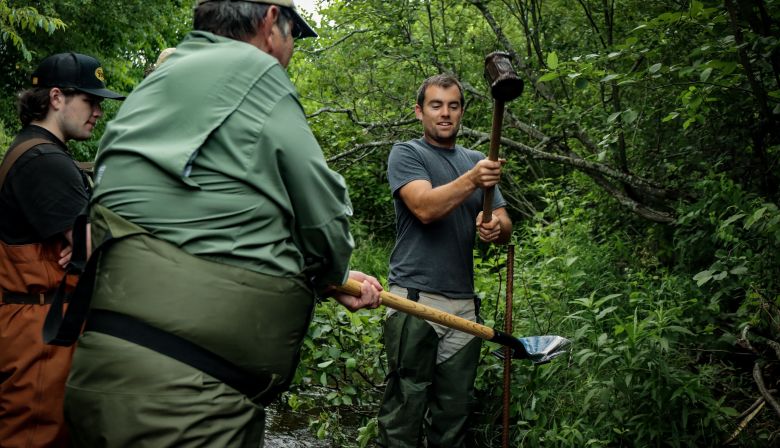
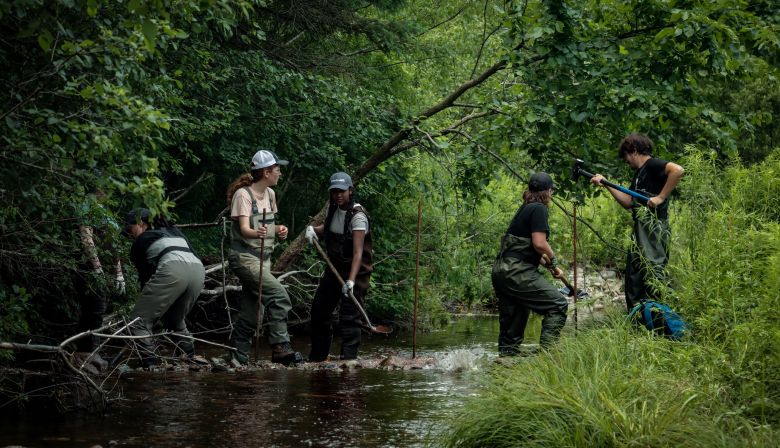

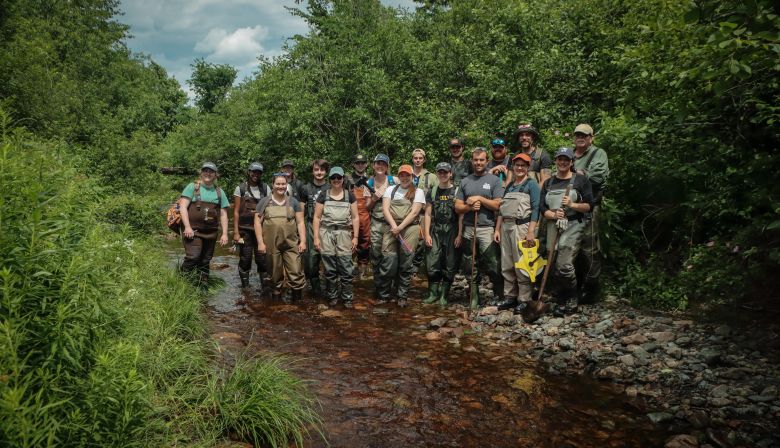

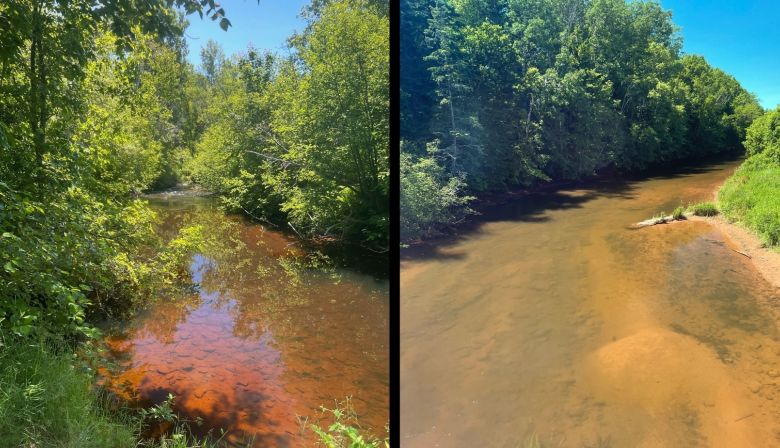
There are fish in the river and many fresh fish coming in. Fishing was tough as within the last week water levels have dropped to very low and temps throughout the days have gone up. Rain is much needed. We fished the E1 salmon branch and many of the pools did have fish but not in large numbers. Our guide David Bishop worked extremely hard and we were able to hook into many beautiful fish but the going was tough.
Karol Furlaga et son fils Julian viennent de rentrer d’une grande aventure de pêche sur le rivière Cascapédia. Karol nous dit:
Le saumon était au rendez-vous et la montaison de poisson frais de la mer continuait de plus belle. La pêche a été difficile au courant de la semaine dernière, les débits d’eau ont diminué à des niveaux très bas et la température de l’eau est devenue plus chaude tout au long de la semaine. La pluie aiderait grandement la situation de la rivière et des pêcheurs. Nous avons pêché la branche saumon dans le secteur E1 et de nombreuses fosses avaient du saumon, mais pas en grande quantité. Notre guide, David Bishop, a travaillé extrêmement fort et nous avons pu attraper plusieurs saumons malgré les conditions difficiles.
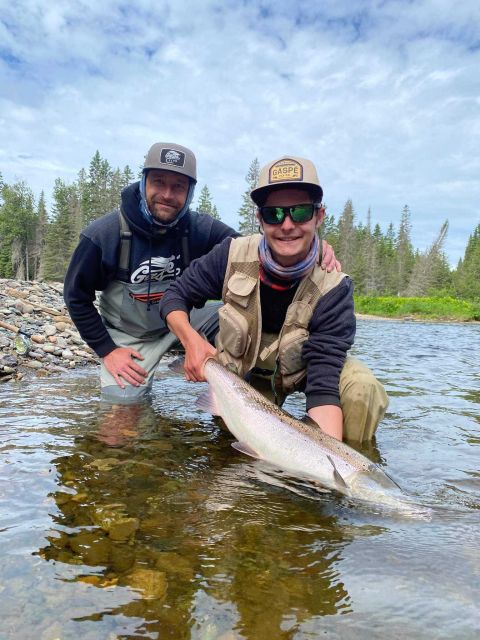
Charles Cusson, Directeur des programmes au Québec, shares:
This week, on the Matane River, the FQSA and ASF are heading up a team including representatives of Réseau des sport (RDS), Moisie River Protection Association (APRM) , Hooké and the Matane River management society (SOGERM) to produce video clips highlighting best practices related to Live Release of wild Atlantic Salmon.
The clips will be unveiled during the spring of 2023.
La FQSA et la FSA mènent un tournage cette semaine sur la rivière Matane afin de produire des capsules vidéo de sensibilisation au sujet des meilleures pratiques de remise à l’eau du saumon de l’atlantique. Les capsules seront dévoilées au printemps 2023. Participant à ce tournage sont des représentants du Réseau des Sports (RDS), l’association de protection de la rivière Moisie (APRM), Hooké et la Société de gestion de la rivière Matane (SOGERM).
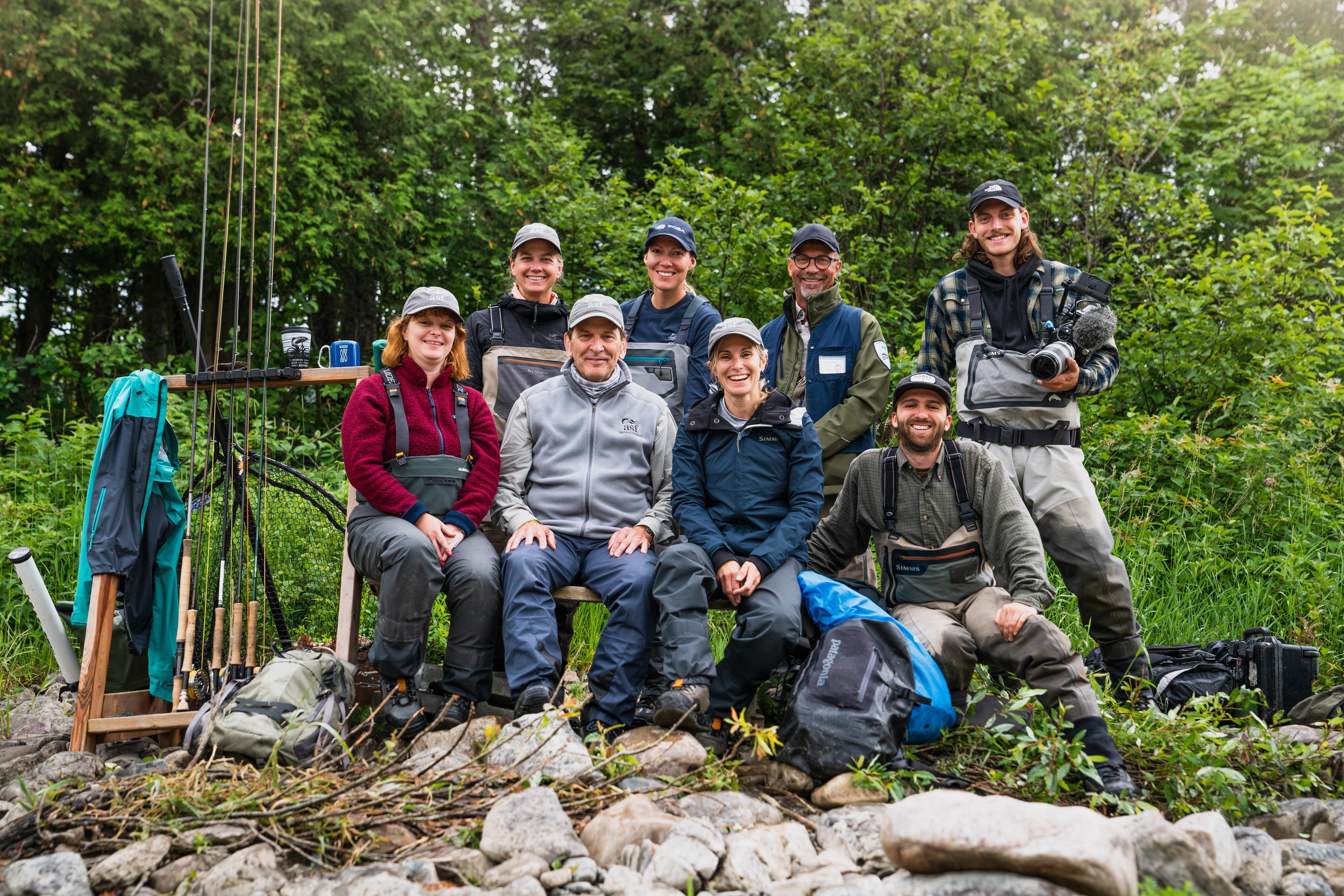
Lots of rain last week resulted in a big raise of water on the Miramichi river last week and that combined with nice cool weather has meant that lots of fish have been cruising comfortably up the river. The positive but rather strange weather is making the 2022 season a memorable one starting out as we are normally worried about low water and hot temps. All great news for the salmon and our fishery however!
Word from local anglers throughout the system is that overall, fishing has been exceptional thus far this year! And those putting time on the water are being rewarded with rolls and hookups which is great to report. Friends from Miramichi City are still seeing multiple salmon and grilse jump daily which is always great news and bodes well for the coming weeks as the July grilse run seems to be starting into the river as it usually does the first or second week of July.
For weekly reports from Country Haven Lodge be sure to visit their website and follow on Facebook.

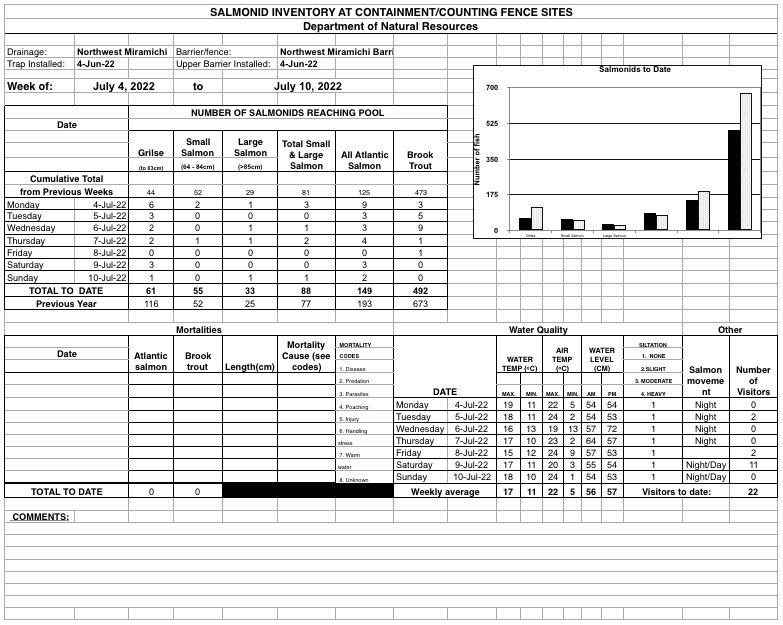
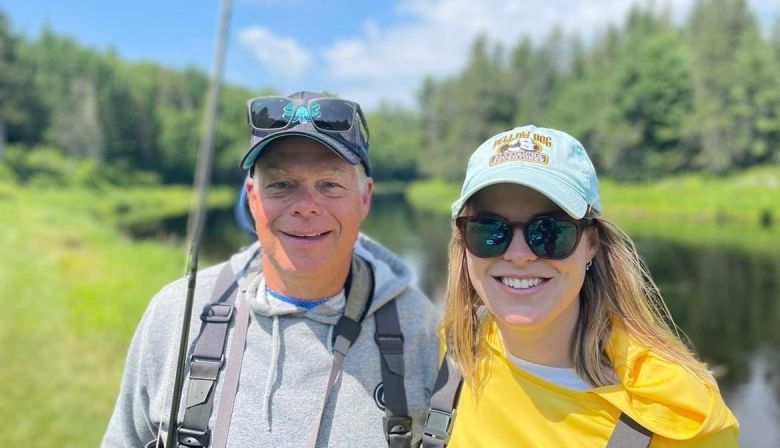
Many Atlantic salmon have been tagged as part of the Environmental Studies Research Fund (ESRF) project with internal acoustic tags (small black cylinder, see photo) or external satellite tags (big black bobber with tail, see photo).
If you catch a salmon with either tag please let me know through the “ESRF Atlantic Salmon” Facebook page or email: SalmonNL@hotmail.com
If you catch a satellite tagged salmon that is being released, please just cut the tag off where the string holds the tag to the harness.
Do not try to remove the harness.
Many thanks to all the collaborators on this project! Please get the word out.

